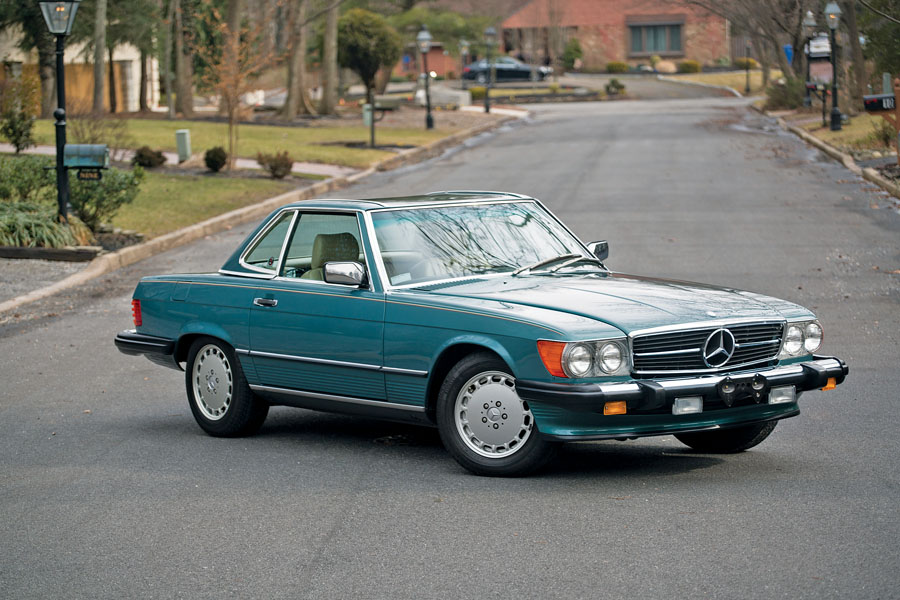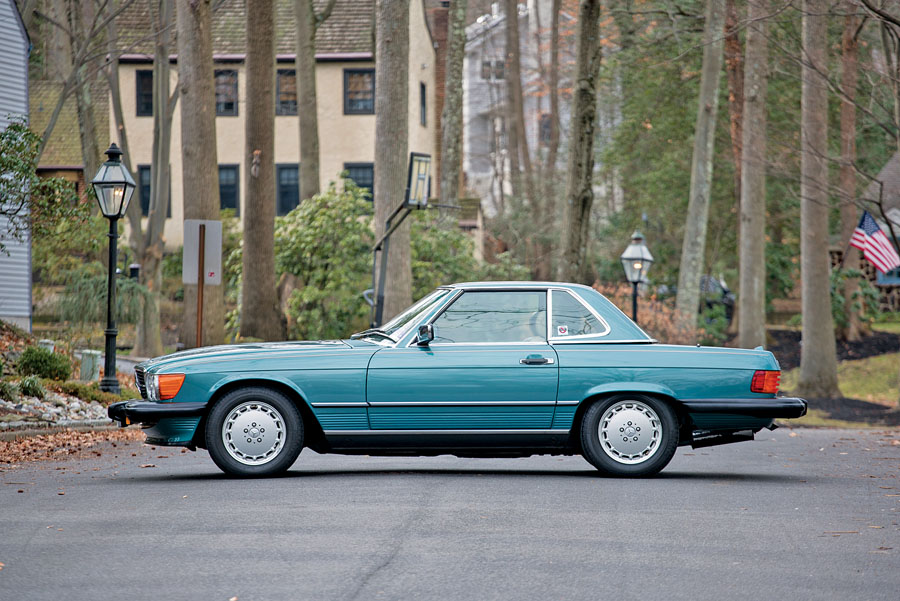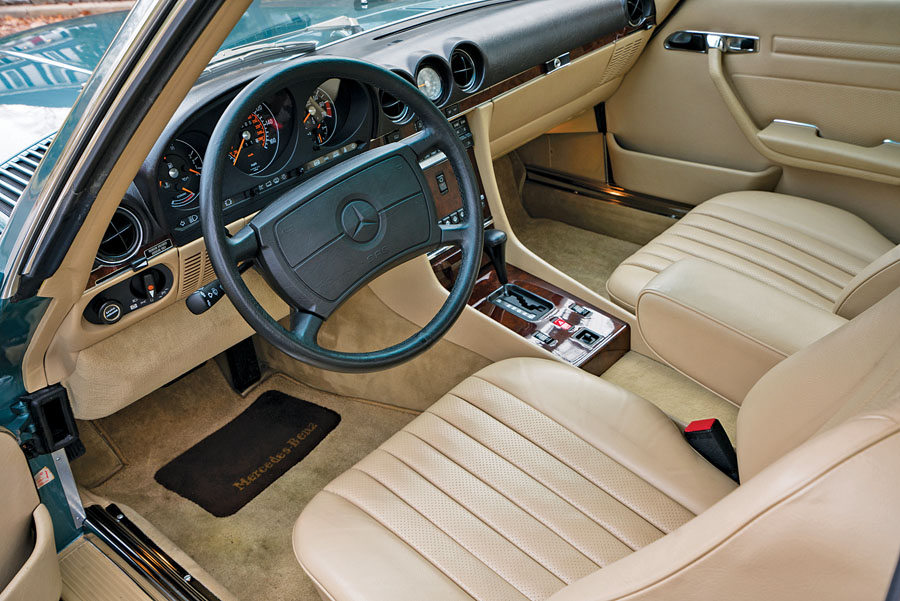SCM Analysis
Detailing
| Vehicle: | 1988 Mercedes-Benz 560SL |
| Years Produced: | September 1985 through August 1989 |
| Number Produced: | 49,347 |
| Original List Price: | $61,125 (1988) |
| SCM Valuation: | $47,950 |
| Tune Up Cost: | $725 |
| Chassis Number Location: | On radiator core support, right of hood latch |
| Engine Number Location: | Directly behind left cylinder head on bellhousing |
| Club Info: | Mercedes-Benz Club of America |
| Website: | http://www.mbca.org |
| Alternatives: | 1986–89 Porsche 911 cabriolet, 1988–96 Jaguar XJS convertible, 1987–89 Pontiac Firebird convertible |
This car, Lot 109, sold for $95,200, including buyer’s premium, at RM Sotheby’s Amelia Island Sale on March 9, 2018, in Amelia Island, FL.
Featuring extremely low mileage — and sporting impressive colors — this is truly one of the best Mercedes-Benz time-capsule cars offered at auction.
Paydirt at last!
A number of 1986–89 500SLs recently hit eye-watering, six-digit prices in the E.U., so it was only a matter of time until a market-shaking 560SL sale occurred.
Back in 2014, Madonna’s Black ’87 sold for similar money at Bonhams’ Mercedes sale, but without the celebrity connection it was, at best, a $20k car.
Our subject car is the first sale of a top-notch 560SL that sold on its own merit for something close to $100k. But why did 560SLs languish for so long? Why are they starting to be appreciated now? And why would someone need to spend $95k on this example when you can find a comparable car with 75,000 miles for around a quarter of the price?
Investment-grade 560SL criteria
Indeed, fellow Mercedes devotees, a new type of 560SL has emerged! Yes, the investment-grade 560SL is finally “a thing.”
Within clandestine groups of Mercedes owners, this market has been under development for a while, with spec collectors hoarding the best cars, locking them up in climate-controlled garages and waiting patiently. Many of them let examples like our subject car go — for less than half of what was realized here — back in 2012 and 2013. Little did they know …
Investment-grade 560SLs must have less than 30,000 miles, but to really get it right, they should have fewer than 9,000 miles. Sub-4,000-mile examples are undergoing a market adjustment as we speak. Period car phones, chrome wheel eyebrows, replacement seat leather, paintwork, aftermarket wheels and stereos will hurt the investment quality of a low-mileage example.
If you’re looking at a 560SL, avoid cars with color changes, body modifications and missing hard tops if you want to get your money back at some point.
Low mileage not required for happiness
If you’re reading this because you want a 560SL to drive and enjoy, you don’t need to buy a 25,000-mile car or even a 75,000-mile car.
The R107 is built to go the distance, with higher-mileage cars being just as robust, reliable and usable as ultra-low-mileage cars.
The only real weak points are timing chains (90,000 to 120,000 miles) and valve guides (175,000 to 250,000 miles). Engine bottom ends, transmissions, climate-control systems and electrical systems are tough and relatively trouble-free — if they are maintained properly.
In my experience servicing these cars, 560SL owners seem to be split down the middle. About half of them over-maintain their cars, and the other half do little to service them. Most were garaged, so if the car is in good cosmetic shape — but has few maintenance documents — you will likely come out ahead after spending about $5k to $7k putting things right.
Ratty, tired examples do exist, but spending an extra $5k to $10k will land you a better example. I would rather have a cosmetically nice, higher-mileage example (over 100k) than a poorly maintained, 30,000-mile car — if my intent were to use the car.
Investment-grade R107s, sadly, are often riddled with deferred maintenance. Most of them have never had a transmission service, new drive belts, or thermostat replacements. Brakes were often fixed as needed, with 10 years or more between fluid changes. A major service would typically occur every 15 years or so, with fluids getting flushed and a/c systems getting topped off — but with no true analysis of the vehicle’s mechanical needs.
560SL market analysis
By now you are probably asking yourself, “What does this sale mean for my R107?” If your R107 is a U.S.-market 380SL or 450SL, the market is still unclear. Gooding & Company attempted to sell a 24,000-mile 1982 380SL the same weekend for $40k, but they came up short. Thankfully, the 560SL has its own market.
Long seen as safe transportation to the golf course, the 560 had links to certain age groups and warm, sunny geographic locations.
Now that a younger generation of buyers has discovered these fun and durable convertibles, prices have mysteriously risen overnight.
It’s obvious that 1988 and 1989 examples bring stronger numbers, possibly as much as by 20%. An example with 90,000 miles and no stories is still worth about $15k, a comparable 75,000-mile example is worth about $20k, and a 50,000-mile example is worth about $30k.
A condition 2, 40,000-mile example would be fairly priced at around $35k, and a 30,000-mile example should be priced above $40k.
Examples with less than 30,000 miles tend to bring much stronger money, with $50k being a fair ask for a car with low twenties or high teens, and $65k is justifiable for a 10,000-mile car. A rare sub-5,000-mile car is a tough one, but if this example were an ’89 and was either black on black or black on dark red, it might have bested $100k.
Market interest is bubbling. After I posted a five-minute video on 560SL values on my YouTube channel, my inbox sizzled with questions. (Go to YouTube.com and search for “Hedary.”)
Investment unicorn hard at work
My old friend, the investment unicorn, was sighted in the European 500SL market several years ago, and is now hard at work on our shores.
About two years ago, many optimistic dealers were lured into the 560SL market. Duped into the snares of the investment unicorn, they started buying and holding 40,000-to-90,000-mile 560SLs, and as a result, the market is flooded with these cars. They aren’t rare, and the market for these cars is not as strong as some people would like for the uninitiated to believe it is.
Real prices are hard to gauge, and each car is different. It’s perfectly reasonable to pay more for an example with clear history, a perfect interior, original paint and higher miles. Mileage should always come second to overall condition with any Mercedes.
What happens after the auction?
This 560SL — and many others in similar condition — will remain as it has been for the past 20 years, sitting in climate-controlled garages with meticulous cosmetic attention. Shown off like trophy spouses, their ever-increasing market values relegate them to display status. Many owners of these cars own a second — or even a third — 560SL that they use and enjoy regularly.
If 560SLs don’t deteriorate with age, what would make someone pay this impressive price for our subject car? In my work preserving and maintaining classic Mercedes, I have learned that some clients simply desire the absolute best example possible, and if that example is available, they will do what they have to do to get it.
This 560SL might be well sold today, but it is definitely a sign of things to come. ♦
(Introductory description courtesy of RM Sotheby’s.)


